Brain Switch/OG
| Brain Switch | |
| Contributors | Takashi Iba, Toko Miyake |
|---|---|
| Last modification | May 17, 2017 |
| Source | Iba & Miyake (2010)[1]; Iba (2010)[2] |
| Pattern formats | OPR Alexandrian |
| Usability | |
| Learning domain | |
| Stakeholders | |
• When you are making research
• When you are creating something
• When you are writing a paper
• When you need to get a new view or idea
• When you are at a dead end
Thinking tends to be leaning to only logic or intuition, which each is not enough to achieve a breakthrough.
• Logical thinking (left brain) inspires acute analysis and inference, and has persuasion.
• Intuitive thinking (right brain) inspires good ideas and expressions, and gives impression.
• It is difficult to use both modes of thinking at the same time.
Think, switching two modes of logic and intuition.
• When you begin to think with your “left brain,” think logically as deep as possible. When you begin to think with your “right brain,” think intuitively as deep as possible.
• Switch your brains when you are at a dead end or think sufficiently. If you have thought with “left brain” by then, try to think about beauty and wealth of expression. For example, when you are writing something, draw pictures of what you express by words. In contrast, if you have thought with “right brain,” try to think about coherence and depth of logic. For example, when you are drawing a picture, think about the logic of the picture. By switching brains, you can find a new aspect of a matter.
Brain Switch means switching ways of thinking that are logical and intuitive. In contrast, Bird’s Eye, Bug’s Eye (Bird’s Eye, Bug’s Eye) means switching viewpoints. If you are used to switching ways of thinking and viewpoints, you will provide Attractive Expression (Attractive Expression).
References
- ↑ Pattern published in Iba, T., & Miyake, T. (2010). Learning Patterns: a pattern language for creative learning II. In Proceedings of the 1st Asian Conference on Pattern Languages of Programs (p. 4). New York:ACM.
- ↑ Patlet mentioned in Iba, T. (2010). Designing a Pattern Language for Creative Learners.
